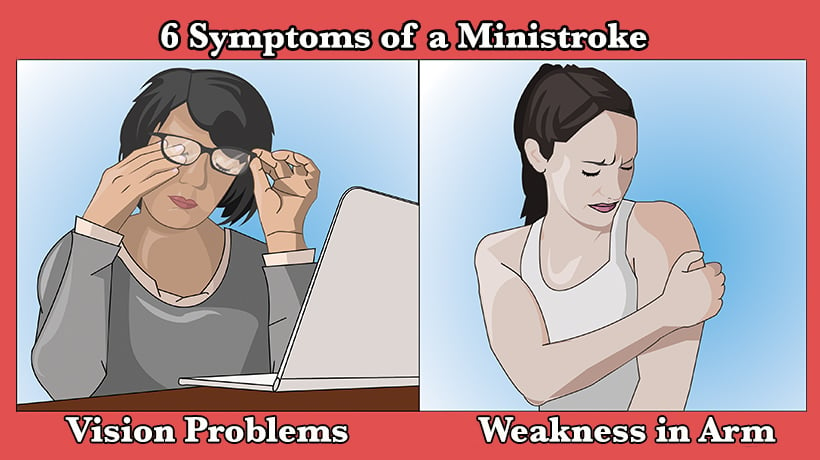Victims of a stroke usually know when they’ve experienced one because it causes a permanent disability. This is because a full-fledged stroke occurs when a blood vessel carrying oxygen and nutrients to the brain is blocked by a clot or ruptured, according to the American Stroke Association (ASA).
But many people may have had a “ministroke” and never notice because it doesn’t cause long-term damage. The ministroke, or a transient ischemic attack (TIA), lasts anywhere between one minute and 24 hours. Despite its brevity, detecting it is important; the ASA says one in three patients who experience a ministroke have a more damaging stroke later. Here are the symptoms you need to know to find help quickly.
Vision changes
The way the ministroke affects the brain can result in problems with your vision. You might experience partial blindness, double vision, or problems with perception, according to the National Stroke Association. Some ministroke survivors experience something called visual neglect, which is when you ignore objects in a certain area. Visual neglect can cause you to eat food from only one half of your plate or shave only half your face.
Weakness on one side of the body
Numbness, tingling, or weakness can affect one side of the victim’s arm, leg, or face, depending on what side of the brain the stroke happened.Dizziness
A ministroke can cause a person to lose balance or feel dizzy. This can cause problems with walking or seeing straight.
Difficulty speaking
Brain damage can cause problems with speech. This might happen due to damage to the language centers in the person’s brain (dysphasia), which hinders comprehension and memory. Alternatively, the victim might be unable to control the muscles needed for speech (dysarthria).
Headache
Usually, people can figure out what causes a headache, be it stress, chronic migraine, or head trauma. If there’s no obvious cause of the headache, it might be related to a ministroke.
Confusion
A ministroke can damage the brain in a way that makes something that was once a simple task much more complicated. Some examples of confused behavior include difficulty with speech or writing, neglect, poor short-term memory, or difficulty solving problems. For example, a stroke victim might not remember how to tie their shoes.
The symptoms for a ministroke and a stroke are nearly identical. Time is of the essence concerning a stroke, so the ASA warns against waiting it out until you see how badly the stroke seems to affect you.
If you suspect someone is having a stroke or a ministroke, the National Stroke Association suggest you Act F.A.S.T.
Face: Ask the person to smile. Does one side of the face droop?
Arms: Ask the person to raise both arms. Does one drop down or waver?
Speech: Ask the person to repeat a sentence. Does her speech slur or?
Time: Call for a doctor immediately.
Sources:
https://www.strokeassociation.org/en/about-stroke
https://www.strokeassociation.org/en/about-stroke/types-of-stroke/tia-transient-ischemic-attack/what-is-a-tia
https://www.stroke.org/we-can-help/survivors/stroke-recovery/post-stroke-conditions/physical/vision/
https://www.webmd.com/stroke/news/20100415/can-you-recognize-symptoms-of-minor-stroke#1
https://www.healthline.com/health/stroke/signs-symptoms-tia-mini-stroke
https://www.mayoclinic.org/diseases-conditions/transient-ischemic-attack/expert-answers/mini-stroke/faq-20058390



